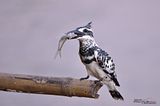A post compiling shots from an ordinary day at Cho Lae. Lots of migrants have already arrived, especially waders. Large flocks of Wood Sandpipers (Tringa glareola) can be found all over the place. Lots of snipes have already arrived as well, but they are just too shy to be seen in the open. Most of them are Pintail and Common Snipes. Several Stonechats are here as well. I'm getting sick by the split of this bird. It used to be just Stonechat (S. torquata), then Siberian Stonechat (S. maurus), and now the eastern race that winters in Thailand is called the Stejneger's Stonechat (S. stejnegeri). From reading through the discussions in Surfbird email archive, it seems that these newly split taxa are basically impossible to be distinguished in the field since they are all split purely on genetic evidences. In the future, I wonder if these new species will be grouped back into a single species like before or not....
 The now so called Stejneger's Stonechat (S. stejnegeri)
The now so called Stejneger's Stonechat (S. stejnegeri)

A flock of Baya Weavers (Ploceus philippinus) was still occupying the same area around its nesting colony though all the chicks have already fledged and joined the flock their parents. Most male birds have already shed their bright golden head feathers and turning into a drab female-like non-breeding plumage.
 A male Purple Sunbird (Cinnyris asiaticus) in eclipse plumage
A male Purple Sunbird (Cinnyris asiaticus) in eclipse plumage
 Wood Sandpipers are abundant but very difficult to get close.
Wood Sandpipers are abundant but very difficult to get close.




 A male Purple Sunbird (Cinnyris asiaticus) in eclipse plumage
A male Purple Sunbird (Cinnyris asiaticus) in eclipse plumage Wood Sandpipers are abundant but very difficult to get close.
Wood Sandpipers are abundant but very difficult to get close.



A fluffing adult Little Ringed Plover (Charadrius dubius); the bird is mainly a winter visitor to Thailand and this one is moulting into a non-breeding plumage.
 A male Pied Bushchat (Saxicola caprata)
A male Pied Bushchat (Saxicola caprata)


 A male Pied Bushchat (Saxicola caprata)
A male Pied Bushchat (Saxicola caprata)

A lone non-breeding Brown Shrike (Lanius cristatus) was also found in the area. It's the subspecies L.c.cristatus, which is a different one from the more reddish superciliosus of Japan. I watched it fed on a very interesting prey, the colourful Long-tailed Lizard (Takydromus sexlineatus ocellatus) which it caught from a small dry field.
 This female Pied Bushchat was much more obliging than the male above.
This female Pied Bushchat was much more obliging than the male above.
 I was lucky to see this shy Slaty-breasted Rail (Gallirallus striatus) coming out to dry its wings after the rain in the late afternoon. It's bird that is not often seen in the open like most of the rail species.
I was lucky to see this shy Slaty-breasted Rail (Gallirallus striatus) coming out to dry its wings after the rain in the late afternoon. It's bird that is not often seen in the open like most of the rail species.
 A landing Pintail Snipe (Gallinago stenura); you can see the blurry 'pin' outer tail feathers
A landing Pintail Snipe (Gallinago stenura); you can see the blurry 'pin' outer tail feathers


 This female Pied Bushchat was much more obliging than the male above.
This female Pied Bushchat was much more obliging than the male above. I was lucky to see this shy Slaty-breasted Rail (Gallirallus striatus) coming out to dry its wings after the rain in the late afternoon. It's bird that is not often seen in the open like most of the rail species.
I was lucky to see this shy Slaty-breasted Rail (Gallirallus striatus) coming out to dry its wings after the rain in the late afternoon. It's bird that is not often seen in the open like most of the rail species. A landing Pintail Snipe (Gallinago stenura); you can see the blurry 'pin' outer tail feathers
A landing Pintail Snipe (Gallinago stenura); you can see the blurry 'pin' outer tail feathers

A new species to my photo library to end this entry, the Asian Koel (Eudynamys scolopaceus), a very common but super shy member of cuckoo family. This one is an immature male. Adult male lack buffish spots on wing coverts, while female has mottled brown plumage. The right image shows the bird with a Black-collared Starling.












2 comments:
Hi A, I really like the picture of the female Pied Bushchat, a very well captured pose. Also the shrike sits in a typical shrike way which you pictured very well. I agree with you about all these splits - we should go back and joinn some up. Over here the redpolls are a nightmare. Too many scientists and not enough birdwatchers to say enough is enough.
Thanks a lot, Phil!
Seems like it's an era of genetic birding lol
Post a Comment